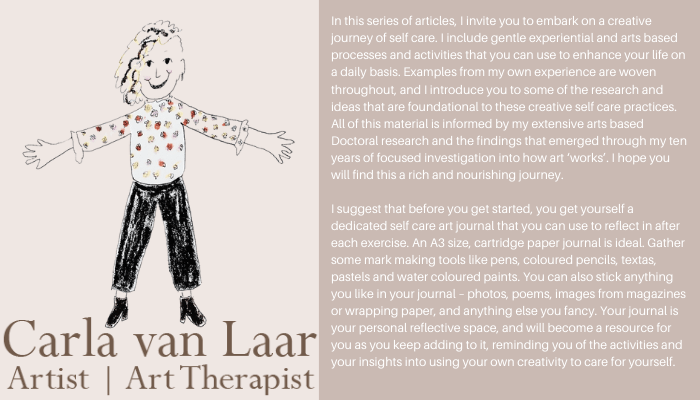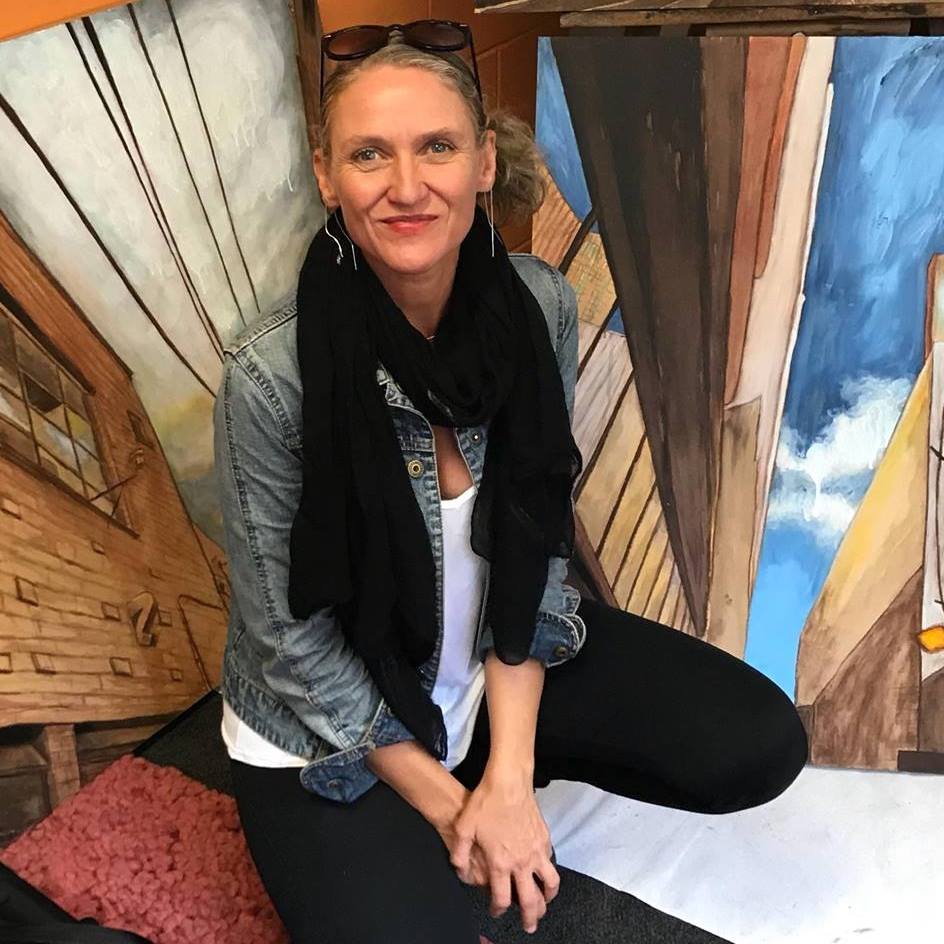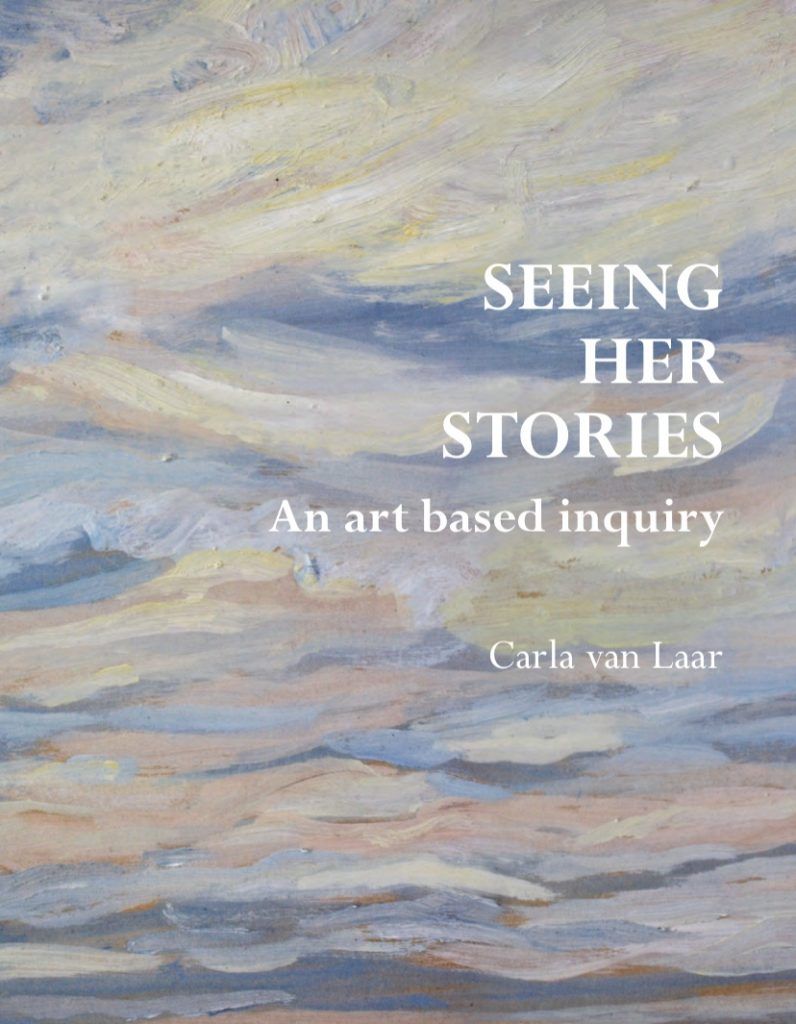With Dr Carla van Laar AThR
Feature image credit Carla van Laar
In this article I share some stories from my Doctoral research that illustrate how we reflected on our creative journeys together, and the ways that these were life enhancing for us. What I learned from this research, is that understanding what enhances our lives is a personal yet also a shared process, and the answers to important questions are often right within us. Sometimes, we simply need to honour our own wisdom and have ways to listen that enable us to hear our own voices telling us what is important.
I then invite you to reflect on your own journey of creative self care, and engage in a process designed to help you hear your own voice and listen to your own wisdom. This activity is designed for anyone who has been engaging in an ongoing process of creative reflection through art making and journalling, and especially for those who have been engaging with the processes in my previous twelve creative self care articles.

Reviewing your Journey of Creative Self Care
In my Doctoral research into sharing women’s stories through art,
“the participants and myself described the life enhancing ripple effects of “Seeing her stories”. We use words that relate to qualities of feeling interested, such as “discovery”, “inspiration” and “fascination”. We communicate being enabled through “possibilities for change”, “choices”, and “actions”. We share our experiences of joy and meaning as we describe our “great fun”, “wonder”, “realisation”, “understanding”, “beliefs”, “knowledge”, “values”, and “love”.
Here is an excerpt from my conversation with Nicola at her house where she describes the links between her seeing of my story, her song-writing, beliefs and actions in the world.
I ask Nicola if she can talk about any meanings, actions or other ripple effects that she connects with her response to the painting of the woman on the cliff.
“Yes! And that’s the song! ‘Be’. For me, song writing is a sub-conscious thing; you don’t know what you’re thinking until you write it, then you look back on it and go, ‘Oh, that’s what I think!’ Writing it cements it, and then it becomes an action. The response is sub-conscious, when you discover what it is and take your brain and you cement it, I realise what I’m thinking about, I write it down, I realise what I’m trying to say.
It becomes a belief system and actions”.
Nicola’s description here reflects the process of art as a way of knowing, or practice as research. Her description here relates well to Heron and Reason’s (2008) expanded paradigm of knowing, and if we simplified her multi-layered experiencing in accordance with their model, we could imagine that she has engaged in experiential knowing through her seeing of my image and later her own song writing, presentational knowing in the performance through music and words, propositional knowing in creating a belief system, and practical knowing about how to put her beliefs into action. The life enhancing properties that Nicola depicts within this process include discovering, realising, believing and actioning. Her insights and learning are personally significant because they have application in her immediate life.
At the research dinner party, Marty also highlighted discovery as an important and life enhancing aspect of being involved in the “Seeing her stories” research project. For her, seeing the artworks and reflecting on the experience is connected with being exposed to many enjoyable feelings, an expanded sense of knowing, and new possibilities for practice. These are all part of discovering through seeing her stories and its ripple effects. She said:
“Well I have been involved in research for a long time, and of course in Carla’s life for a long time. And I think that research is about finding out about things that we don’t already know. And so for me, Carla’s Master’s research really showed me what arts based research can be, and I found that amazingly inspiring because it is a little bit outside of the convention. We may know that these things exist, but to actually be closely exposed to it, enables you to know it, in a much more real way. And so I found that really quite fascinating, as well as very inspiring, and of course I was very proud of the work that Carla did.
I do think, that with this current project, it’s really been a privilege for me to see it unfolding, and along the way, it’s been wonderful to see the artworks, and to see the portraits, it’s all great fun, and I feel that the whole project is very enriching, but at the same time, that the sense of discovery, the sense of finding out about this style of research and what it can accomplish, and what it can communicate, and how this kind of research enriches knowledge, and contributes to understanding in a very complex way. It’s really wonderful to find out about this through Carla’s work, to be exposed to it, and to find out things that I wouldn’t be exposed to otherwise and have the opportunity to find out.”
Marty highlights a number of overlapping themes that help us to understand how being engaged in seeing artworks can be life enhancing. She acknowledges the complexity of knowing and understanding. The emphasis she places on meaning making processes shows us something of her value system – that these things are important to her. She accentuates exposure to new research and involvement in the process as significant, and describes how these experiences are generative and inspiring, showing that her involvement has been motivating and energising.”
(van Laar 2020)
…
I am now going to invite you to review your own journey of creative self care, and reflect on where you were at the beginning of this journey, and where you are now.
…
Reflecting on the Journey
I invite you to return to the very beginning of this journey of creative self care that you have embarked on.
Please go back to your journaling from Module 1 “Coming to our senses” Part 1 “Relaxation”.
Read over your journal entry and re-connect with your experience at the beginning of this journey.
From this journal entry, select three key words that seem to summarise where you were at in that point in time. Write the words on a fresh page, in a line.
Repeat this process for each of the following exercises that you have engaged with to this point. Reading your journal, selecting three words and writing them on a line under the preceding line.
You have engaged in twelve processes so far, so, by the time you have read them all, selected three key words and added these to the list on your page, you should have a list that is twelve lines long.
…
Now, on a fresh page, use these words to create yourself a poem. It doesn’t need to rhyme, but it can at times if you like. Some of the lines of your poem might be longer or shorter than others. It does not have to follow a traditional format, you can make it up to suit yourself.
…
When you have completed your poem, read it out loud to yourself. You might like to record yourself reading the poem, so that you can then listen back to it and hear the words again.
…
When you have completed writing, reading, recording and listening to your poem, create an artwork that reflects aspects of your poem that are especially significant. You might make this as an abstract artwork, and simply use colours, shapes, lines, light and shade to show your journey of creative self care. You can make a page in your journal, and use drawing materials, paint, collage, fabric scraps and textiles, or anything else you might like to use.
…
Questions for Reflective Journaling
When you have finished working with both your poem and your artwork here are some questions to ask yourself in your journal:
- What was it like to read my poem out loud?
- What do I notice about my journey of creative self care?
- Where was I at the beginning, and where am I now?
- What has changed?
- When I look at my new artwork, what do I see, and what does this tell me about myself?
…
References
van Laar, C. (2020) Seeing Her Stories. Carlavanlaar.com, Brunswick, Australia.

Dr Carla van Laar
Artist | Art Therapist
Master of Creative Arts Therapy
Doctor of Therapeutic Arts Practice
Registered Supervisor and Professional Member ANZACATA
Carla van Laar is a painter and therapeutic arts practitioner from Australia. Born in Brisbane, Carla is first generation Australian on her Dutch grandparents side, and 7th generation through her maternal bloodline who were mostly English and came to Australia in the early colonisation of the 1800s. Carla currently lives and works in Victoria, residing between Wurrundjeri country in Melbourne, and Boon Wurrung country in Inverloch, paying deep respects to the First Peoples of the Kulin Nations whose land was never ceded and will always be Aboriginal land. Identifying as a cisgender woman, Carla is passionately disinterested in socially constructed identities that disempower anyone. Carla has over 25 years’ experience working with people and the arts for health and well-being in community organisations, justice, health and education contexts.
Carla’s first book “Bereaved Mother’s Heart” was published in 2007 and broke social taboos about maternal grief. From 2008-18 she established and ran an independent art therapy studio and gallery in Melbourne. Her Doctoral research “Seeing Her Stories” continues the mission to make women’s stories visible, through art.
Carla has lectured and supervised Art Therapy students at RMIT, MIECAT and currently the IKON Institute. She is a practicing artist and in 2018 received an Artist Fellowship at RMIT’s creative research lab, “Creative Agency”. She insists on being part of a creative revolution in which art re-embodies lived experience, brings us to our senses, makes us aware of the interconnectedness of all life and is an agent of social change.
Carla’s new book “Seeing her stories” presents her research into making unseen stories visible through art, and is available to read for free online here or purchase a hard copy of the full colour hard cover coffee table book here.



Leave a Reply